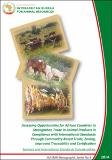
The prevalence and determinants of substance use (a lcohol, khat, cigarette), mental illness, suicidal attempt, STDs and teenage pregnancy among adolescents aged 10-24 years have not been well documented in the country. A community based cross-sectional study was conducted in Awassa Zuria Woreda, southern Ethiopia from November to December 1994 G.C. A total of 1953...

This is a randomized community trial which was carried out to compare the relative effectiveness of three modes of ORT in under-5 children with acute diarrhea; to identify the factors associated with compliance and to assess mother's perception of ORTS. The three ORTS were GORS(n=98), prepacked CBORS (n=90), and home made CBORT (n=103). These alternative ORT the...

Background: Neonatal period is the age of child’s first 28 days from birth to 27compeleted days of life. The neonatal period represents the most vulnerable time for a child’s survival. Nearly half of under-five death globally was occurred during neonatal period. Neonatal mortality rate in Ethiopia is 29 deaths per 1000 live births in 2016. Objective: The objective...

Background About half of the global population and over 70% of countries in the Sub-Saharan Africa rely on biomass fuel as a source of household energy. Over 95% of households in Ethiopia use biomass fuel for cooking. Despite the prevailing major concerns among policy makers and professionals on air pollution, the magnitude of air pollution from domestic and tr...

Background: Alcohol use disorder (AUD) is disabling yet neglected and frequently left untreated in low- and middle-income countries (LMICs). To increase the treatment rate, AUD services need to be integrated into primary health care (PHC) units as people with the disorder often make contact with PHC due to physical health consequences of AUD. Objectives: 1) To dete...

Although oral disease is a major public health problem, there is little epidemiological research in Ethi opia, This study is designed to provide base-line information on the major oral health problems among primary school children in Addis Ababa, A school-based cross-sectional study to assess the oral health status of primary school chi ldren aged 12 years and...

Background Analysis of spatiotemporal dynamics of malaria data of health care systems along with climatic variables and assessment of the intervention tools provides important insights into the changing malaria situation, which might guide adjustments of malaria program activities and priorities of malaria research topics. The objectives of this study were to comp...

A field trial to assess the effectiveness of a reminder sticker in reducing immunization dropout rates was conducted in two districts of Addis Ababa between October 14, 1991 and January 31, 1992. A total of 703 children were entered into the study. The study population was divided into intervention and control groups according to a randomly determined schedule...

Background: To provide health services for the increasing Ethiopian population the government has increased the number of health facilities. To offer efficient and effective health services, however, patients’ medical record keeping or management system is very important. In line with this, some developed countries have undertaken the transition to Electronic Medic...

Introduction: Knowledge management is the planning, organizing, motivating, and controlling of people, processes and systems in an organization to ensure that organizational knowledgerelated assets are improved and effectively employed. The study aims, to assess knowledge management practice, at the Federal Ministry of Health and its affiliate organizations in Ethi...
Countries in sub Saharan Africa (SSA) who do not yet have the advantage of OIE recognized free zones or status for animal diseases are currently experiencing a comparative disadvantage for entering international trade in animals and animal products. With boneless beef making up approximately 84% of total trade in beef and an increase in value in parallel with total...

AIDS is an extraordinary kind of crisis; it is both an emergency and a long-term development issue. In 2003, the Global PLWHA was 38 million out of which 2/3 (25 million) are in Sub-Saharan Africa. In Ethiopia, there are an estimated 1.5 million PLWHA with a prevalence of 4.4 % in 2003. In Tigray, Northern Ethiopia, the adult prevalence of HIV/AIDS is 4.4 % wit...
